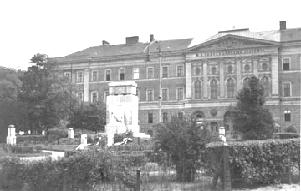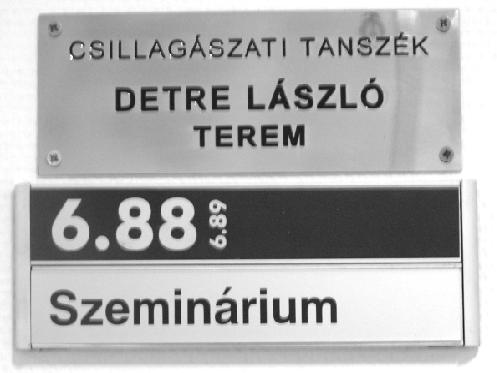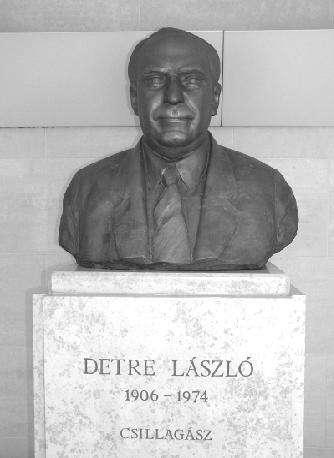Bálint Érdi
Department of Astronomy
László Detre was appointed as professor and head of the Department of
Astronomy of the Eötvös University from the 1st of August, 1964. Since he also was the director of the Astronomical Institute of the Hungarian Academy of Sciences, he served as a half time professor at the University. He was the leader of the Department of Astronomy until 1968 when, as a result of an agreement between the Academy and the University according to which a person cannot be a director of two institutes simultaneously, he resigned as head of department. He continued, however, giving lectures at the University as honorary professor until his death in 1974.
Before professor Detre the Department of Astronomy was led by István Földes, and Detre was followed as head by Béla Balázs.
The staff of the Department of Astronomy between 1964-1968 was
Until 1967 the Department of Astronomy was in the main building of the Faculty of Natural Sciences at Múzeum Blvd. 6-8 on the first floor, where it had two rooms. Entering the department from the corridor there was a larger room which served as a seminar room and a library at the same time, and from here opened a smaller room for the staff, where in most of the cases only M. Marik could be met. Others came in just before their lectures.
In the early spring of 1967 the Department of Astronomy, together with other departments of the Faculty of Natural Sciences, moved to the building of the former Military Academy, the Ludovika, with the promise of being there just for a short transitory period, until the new campus of the Faculty would be built. This transitory period, however, lasted for more than three decades, and the author of this paper, who was a student of the department at the time of the movement, often thought that probably the department would still be in the Ludovika when he would retire.
In the building of the Ludovika the Department of Astronomy had a larger place and an astronomical research laboratory, supported both by the Academy and the University, could also be set up with the aim at reducing the large number of observations made by the Schmidt telescope of the Konkoly Observatory's Piszkéstetö Mountain Station.
The regular astronomy education in the Eötvös University was initiated and organized by professor Detre. It began in the fall semester of the academic year 1965/1966. The Ministry of Education approved professor Detre's proposal according to which in each year four students, majoring either in physics, geophysics, or teaching of mathematics and physics, could also study astronomy from the third year as an additional major discipline, and after a successful state examination receive a university diploma in astronomy. Prior to this date astronomy could only be learned in special courses. The first diplomae in astronomy were issued in 1968.
While professor Detre was the head of the Department of Astronomy, among the students of the department were: Lajos Balázs, István Fejes, András Horváth, Péter Olaj, Koppány Thaly, József Abaffy, Szabolcs Barcza, István Jankovics.
Below is a (non-official) list of the students of astronomy with the year of the diploma whom professor Detre taught.
1968: Bálint Érdi, György Flórik, Lajos Galambos, László Varga;
1969: Barna Apagyi, Csaba Békássy, Sándor Nagy, Gyöngyi Rovó;
1970: Péter Horváth, Gábor Kilvády, Attila Matisz, Zoltán Nagy, Viktor Rónay;
1971: Lajos Márky-Zay, László Szabados, Gábor Szécsényi-Nagy, László Tihanyi;
1972: György Csaba, Mária Kun, László Patkós;
1973: József Csörgei, Pál Halász, János László Kókai, Anikó Paál;
1974: Lídia Gesztelyi, Attila Grandpierre, Katalin Oláh, Margit Paparó;
1975: Szaniszló Bérczi, Elöd Both, Géza Kovács, Gábor Taracsák;
1976: András Bardócz, János Kelemen, Róbert Szabó, László Tóth, Márta Varga, Zsuzsanna Vizi.
Students who wanted majoring in astronomy from the third year, in the first two years had to take up an introductory course. In the following the schedule of astronomy courses is given. The numbers after the course names mean the number of hours per week, for example 2+1 means 2 hours lecture and 1 hour practice in a week. The lecturers' names are also given.
3rd year:
4th year:
5th year:
The course of general astronomy was developed by professor Detre. It included fundamental astronomy, physics of the Sun and the stars, and stellar systems. Beside these fields he also reviewed the latest results of astronomy in his lectures and seminars.
In the lectures on theoretical astrophysics by M. Marik mainly the theoretical methods were treated in the fields of the physics of stellar atmospheres and the interstellar matter, and cosmic electrodynamics.
Celestial mechanics was taught by I. Földes, more known in astronomical circles by his widespread interest in music, languages, and arts. His lectures covered the two-body problem, an introduction to the theory of perturbations, Delaunay's lunar theory, and somewhat surprisingly the theory of motion of artificial satellites.
Teaching of practical astronomy was the territory of B. Balázs. This included photographic and photoelectric photometry, techniques of astronomical instruments, and methods of evaluation of astronomical measurements. In the academic year 1967/1968, because of his research work in the USA, B. Balázs was substituted by Béla Szeidl who gave lectures on photoelectric photometry (fall semester) and on astronomical measuring technics (spring semester).
Professor Detre was internationally recognized for his variable star research. In his lectures, however, he covered all aspects of contemporary astrophysics not only the field of variable stars. He conveyed the most important recent results to his students and made them aware of the actual problems and main research directions. The years of the 1960's were especially rich in outstanding astronomical discoveries, several of them were later recognized by Nobel prize in physics. All these discoveries were discussed in detail in professor Detre's lectures. The main topics were the quasi stellar radio sources, the cosmic X-ray sources, the pulsars, the cosmic microwave background radiation, the beginning of infrared astronomy, and the observations of interstellar molecules. Throughout the years more and more information became available on these subjects, and he thoroughly followed the advance of all fields and was always up-to-date in the events, explanations and denials.
Interestingly, he lectured also on quite distant fields. He had several lectures on the phenomena of solar activity. In one year he gave a semester on supernova research. Years later, when I remember his lectures, the most interesting for me was that even he had given lectures on celestial mechanics. The difficult subject that I had heard from him as a student, later I recognized as the J2 theory of the Earth's artificial satellites by the Poincaré-Zeipel method. This was undoubtedly due to his close relation to Imre G. Izsák, an internationally known expert of artificial satellite research at that time.
Professor Detre provided broad, comprehensive knowledge of astronomy and astrophysics to his students, many of whom became well known researchers of their fields playing leading roles in international bodies and organizations of astronomy.
László Detre had been a professor of the Eötvös University for ten years. His effect, however, has lasted longer than ten years, since the teaching of astronomy in the Department of Astronomy has been continued for decades, until very recently, on the bases established by him.
The University keeps memory of Professor Detre. A seminar room of the Department of Astronomy in the new university campus at Lágymányos has been named after him making Detre's name known and familiar for younger generations, and not only in astronomy. A bust of him has also been erected in the hall of the Faculty of Natural Sciences, among the busts of other great professors of the University.
Loránd Eötvös University,
Budapest, Hungary 


